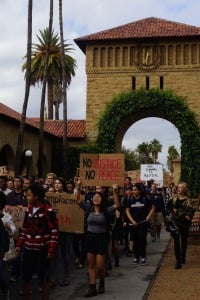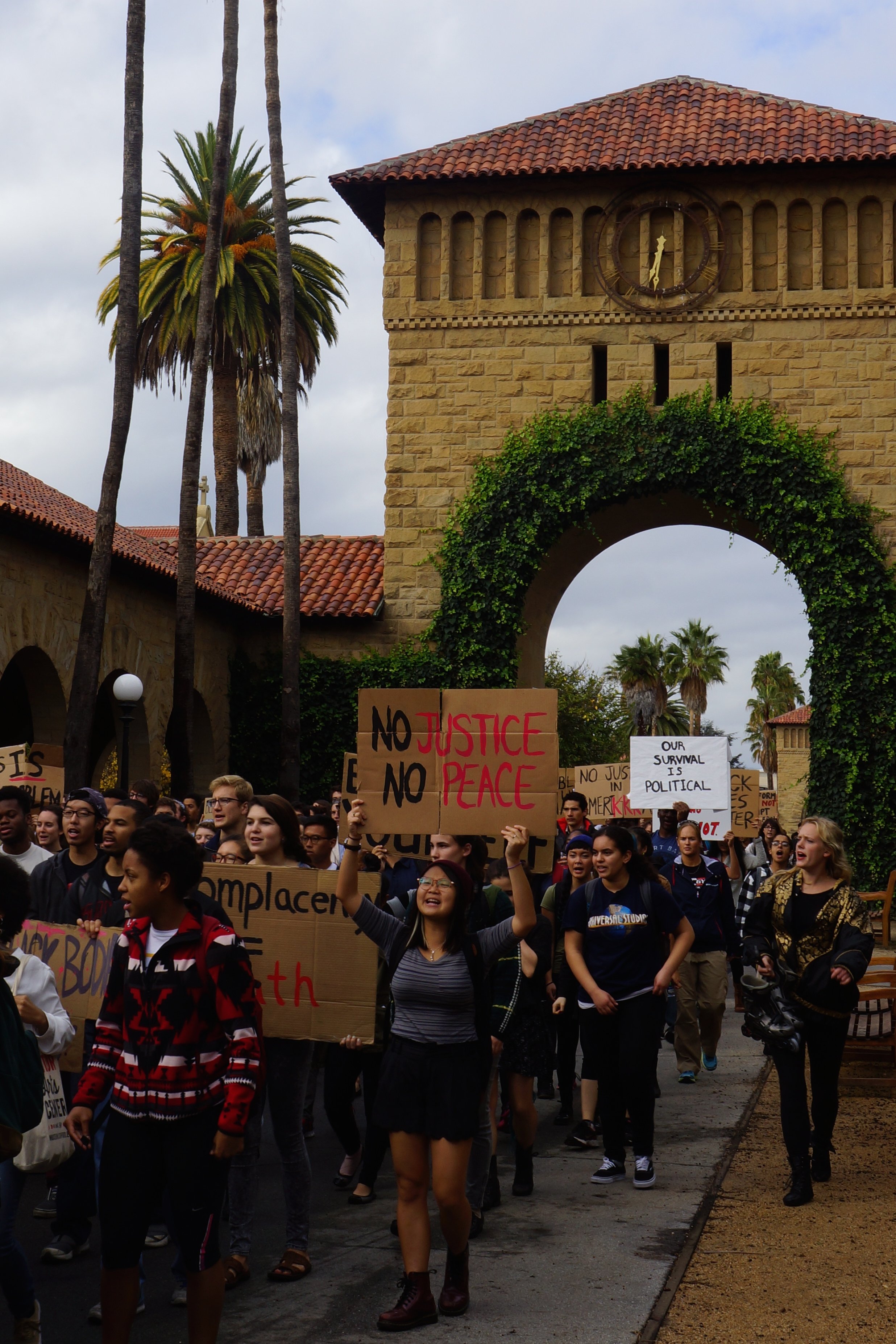
Hundreds of students and other members of the community walked out of classes or other commitments on Monday at 10:01 a.m. to join a national protest of the no-indictment decision of the police officer that shot and killed Michael Brown. Brown was shot at 12:01 p.m. Central time on Aug. 9, 2014, in Ferguson, Missouri.
The demonstration was facilitated by the Palo Alto State of Emergency group, a coalition of individual members from various social justice groups in the Stanford community.
“We’re here during Dead Week because we want people to understand that this movement is more than a chemistry final or more than a test or something that’s due during Dead Week,” said Shelby Sinclair ’14, an organizer for the event, dubbed #HandsUpWalkOut. She estimated that between 500 and 600 people attended the walkout, about double the number that participated in Tuesday’s Silicon Shut Down demonstration.
A few of the event’s organizers shared personal vignettes before Measha Ferguson-Smith ’17 pumped up the crowd gathered in the Main Quad by practicing chants such as “Out of the dorms, into the streets!” and “Hands up, don’t shoot!”
“We’re here for all the people whose lives have been stolen, who have been taken by the systems of oppression, and we are taking a stand,” Ferguson-Smith said to the group before marching off campus. “We’re refusing to be complacent anymore.”
After leaving campus, the crowd broke off into two groups, one stationed at El Camino and Galvez, the other at Page Mill and El Camino. Lining up across all four crosswalks, the protesters blocked traffic.
Kinsey Morrison ’18 missed two classes because she could not merely stand by and watch, she said.
“The color of my skin is not my choice, but the sound of my silence would be,” Morrison said.
For Paul Watkins ’17, another of the walkout’s student leader, the shooting hits home. In his speech he described his personal experience with the Brown case over the summer and during Thanksgiving break in Ferguson, his hometown.
“There were policemen in riot gear all decked out, throwing tear gas canisters, which is stuff you hear about on the news, but it’s different to see it and then come back to Stanford, where everything’s just fine,” Watkins said after the protest. “It’s weird, but knowing that there are people who are trying to maintain that solidarity and maintain a continuous action plan is a good feeling.”
Watkins emphasized that though the news often dramatizes the violence of rioters, it is important to consider the actions of nonviolent protesters as well.
“Yes, there were break-ins into shops,” Watkins said, “but I also saw people just standing and singing songs and marching and doing everything very peacefully. I guess it’s mentioned on the news but it’s not the primary focus, and I feel like it should be.”
Cole Manley ’14, president of Students for Alternatives to Militarism, encouraged members of his club to take part in the demonstration and joined his entire introductory improvisation class in walking out to participate in this movement, one he believes is central to the anti-militarism effort.
“It’s very important for activist groups to be allies to this movement in Ferguson, to recognize the intersectionality of this movement, [to recognize] that police brutality, militarism, militarization of the police — these issues are all connected to the broader issues that our communities face,” Manley said.
Manley stated that persistent protesting is necessary to fight for this cause. According to him, interrupting one’s everyday business seems like a minor inconvenience when compared to the major brutalities regularly faced by minorities.
“There is going to be sustained action on the part of Stanford activists and Stanford community members and Stanford students, because this movement isn’t stopping,” he said. “It’s not stopping at El Camino, it’s not stopping in Ferguson, it’s nationwide.”
Contact Tristan Vanech at tvanech ‘at’ stanford.edu.
